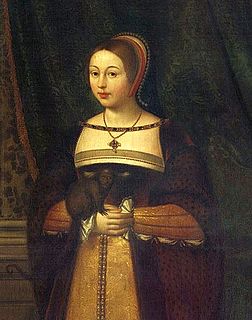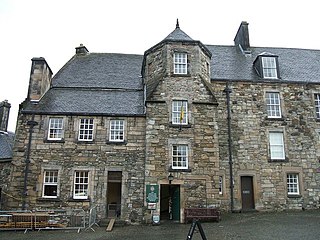
Perkin Warbeck was a false pretender to the English throne. Warbeck claimed to be Richard of Shrewsbury, Duke of York, who was the second son of Edward IV and one of the so-called "Princes in the Tower". Richard, were he alive, would have been the rightful claimant to the throne, assuming that his elder brother Edward V was dead and that he was legitimate—a point that had been previously contested by his Uncle, King Richard III.

James IV was King of Scotland from 11 June 1488 until his death at the Battle of Flodden in 1513. He inherited the throne at the age of fifteen on the death of his father, James III, at the Battle of Sauchieburn, following a rebellion in which the younger James was the figurehead of the rebels. James IV is generally regarded as the most successful of the Stewart monarchs. He was responsible for a major expansion of the Scottish royal navy, which included the founding of two royal dockyards and the acquisition or construction of 38 ships, including the Michael, the largest warship of its time.

Margaret Tudor was Queen of Scotland from 1503 until 1513 by marriage to King James IV. She was the eldest daughter and second child of King Henry VII of England and Elizabeth of York, and the sister of King Henry VIII of England.
Sir Andrew Barton was a Scottish sailor from Leith. He gained notoriety as a privateer, making raids against Portuguese ships. He was killed in battle and memorialised in English and Scottish folk songs.

Michael, popularly known as Great Michael, was a carrack or great ship of the Royal Scottish Navy. She was the largest ship built by King James IV of Scotland as part of his policy of building a strong Scottish navy.
Margaret Drummond was a daughter of John Drummond, 1st Lord Drummond, and a mistress of King James IV of Scotland.

Andrew Forman was a Scottish diplomat and prelate who became Bishop of Moray in 1501, Archbishop of Bourges in France, in 1513, Archbishop of St Andrews in 1514 as well as being Commendator of several monasteries.
The Treaty of Perpetual Peace was signed by James IV of Scotland and Henry VII of England in 1502. It agreed to end the intermittent warfare between Scotland and England which had been waged over the previous two hundred years and although it failed in this respect, as the hostility continued intermittently throughout the 16th century, it led to the Union of the Crowns 101 years later.
Margaret was a Scottish warship of the 16th century.
Ladykirk is a village on the B6470 in the Scottish Borders area of Scotland, and the former Berwickshire, just north of the River Tweed and the Anglo-Scottish border. The town was formerly known as Upsettlington, but King James IV of Scotland renamed the town Ladykirk; the church is also known as St Mary's Church or Kirk of Steill. Ladykirk stands directly opposite Norham Castle, Northumberland, England
Lady Catherine Gordon was a Scottish noblewoman and the wife of Yorkist pretender Perkin Warbeck, who claimed he was Richard of Shrewsbury, Duke of York. After her imprisonment by King Henry VII of England, she became a favoured lady-in-waiting of his wife, Elizabeth of York. She had a total of four husbands, but there are no records she had any surviving children.
Mary Willoughby was a ship of the English Tudor navy. She appears in the navy lists from 1535, during the reign of Henry VIII. She was named after Maria Willoughby, a lady-in-waiting and close friend of Catherine of Aragon. The ship was taken by the Scots in 1536 and was included in the Royal Scots Navy, The English recaptured her in 1547. The ship was rebuilt in 1551, increasing in size from 140 bm to 160 bm.
Lion was the name of five warships of the Royal Scottish Navy during the 16th century, some of which were prizes captured by, and from the English. The names of these ships reflect the Royal Arms of Scotland and its central motif of the Lion Rampant.
Robert Barton of Over Barnton was a Scottish landowner, merchant, sailor and politician. He served as Comptroller, Master of the Mint and Lord High Treasurer to James V of Scotland.
Don Pedro de Ayala also Pedro López Ayala was a 16th-century Spanish diplomat employed by Ferdinand II of Aragon and Isabella I of Castile at the courts of James IV of Scotland and Henry VII of England. His mission to Scotland was concerned with the King's marriage and the international crisis caused by the pretender Perkin Warbeck. In his later career he supported Catherine of Aragon in England but was involved in a decade of rivalry with the resident Spanish ambassador in London. Ayala was a Papal prothonotary, Archdeacon of London, and Bishop of the Canary Islands.
John Damian de Falcuis was an Italian at the court of James IV of Scotland. His attempts at medicine, alchemy, flying, and his advancement by the king encouraged a satirical attack by the poet William Dunbar.
Andrew Halyburton or Haliburton was a Scottish merchant.

Ellen or Elen More was an African servant at the Scottish court. There are records of clothing and gifts given to her. Some recent scholarship suggests she was a slave.

Andrew Aytoun, was a Scottish soldier and engineer, and captain of Stirling Castle.

Walter Merlioun, was a Scottish master mason based in Edinburgh.








